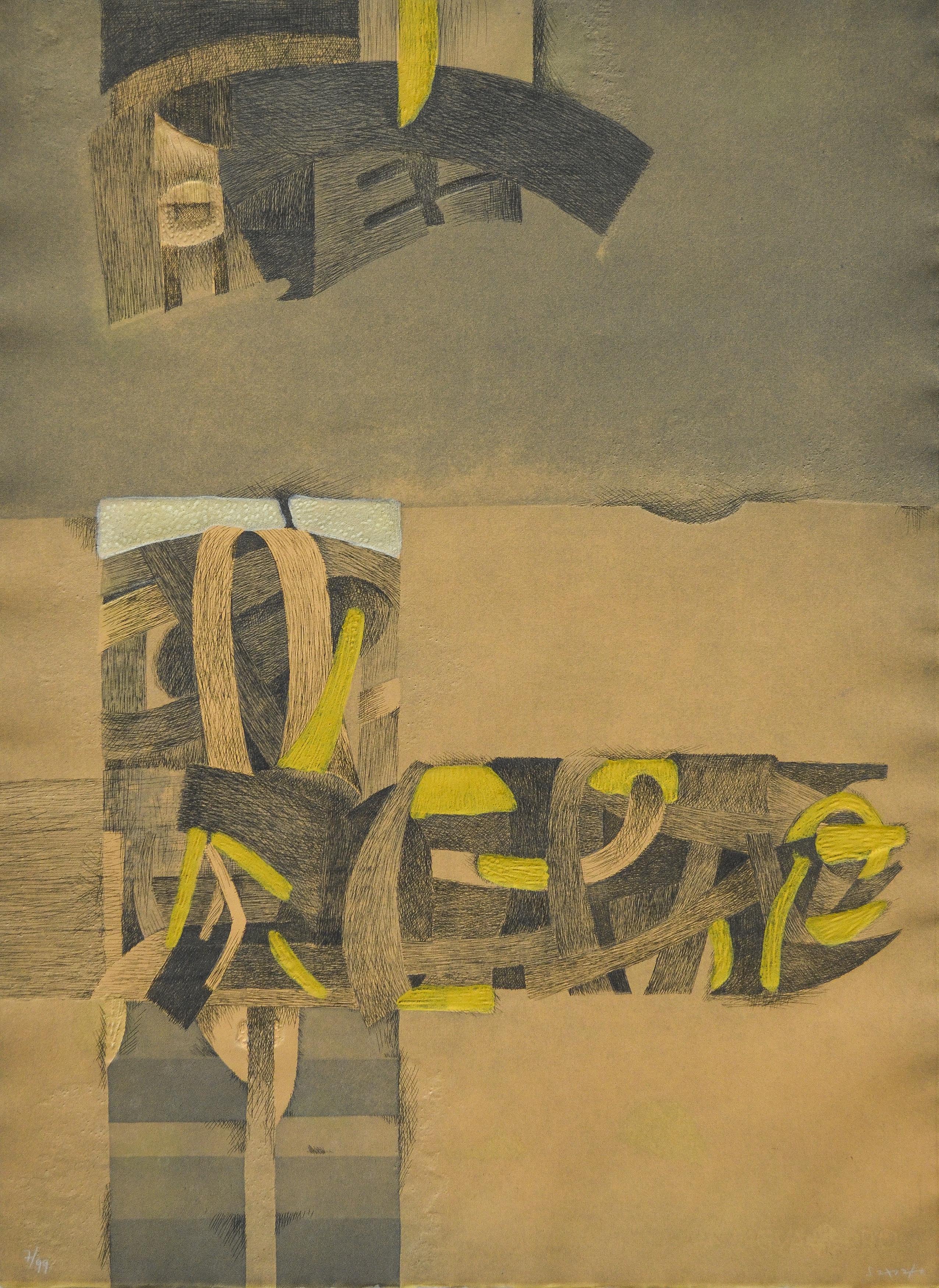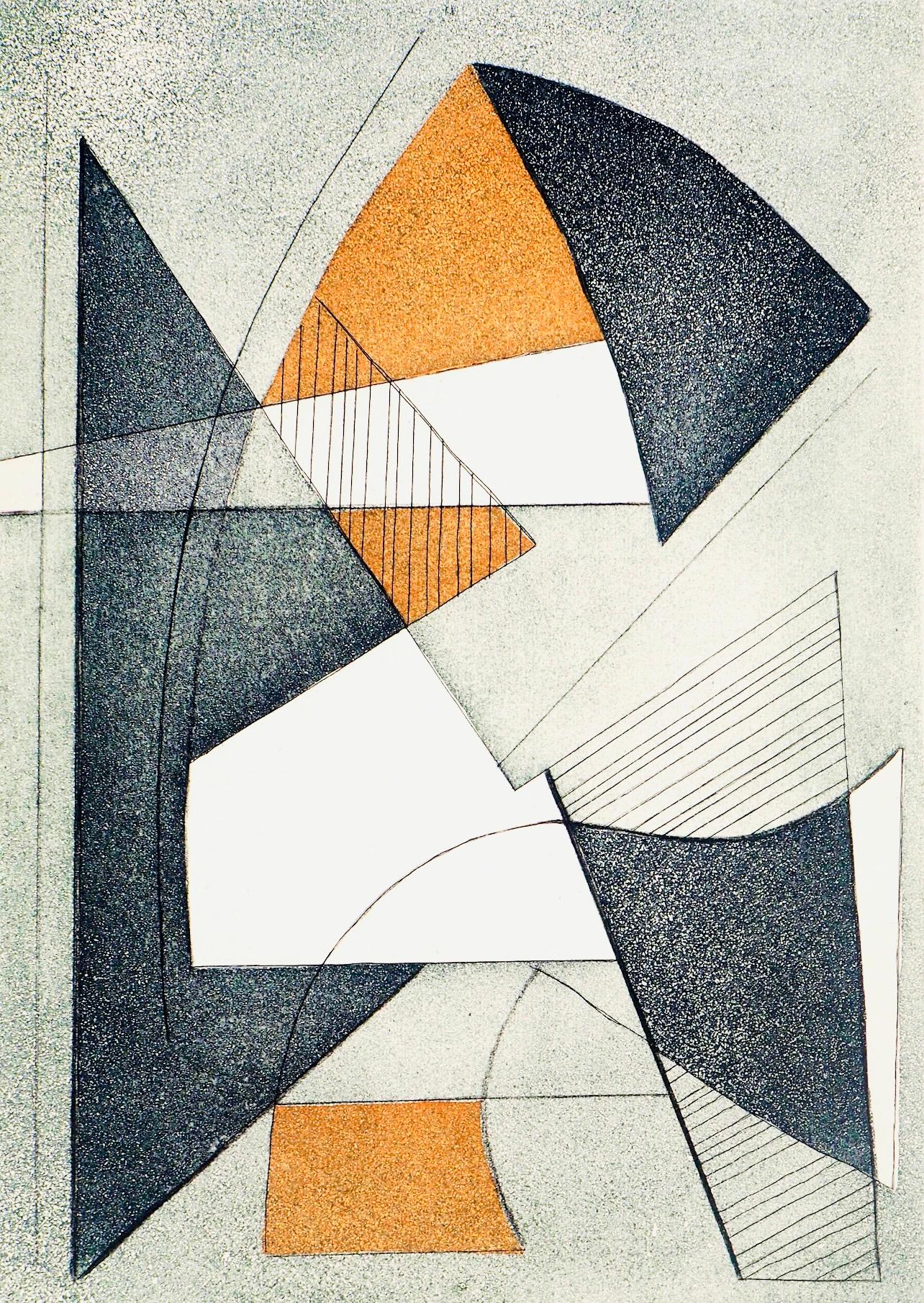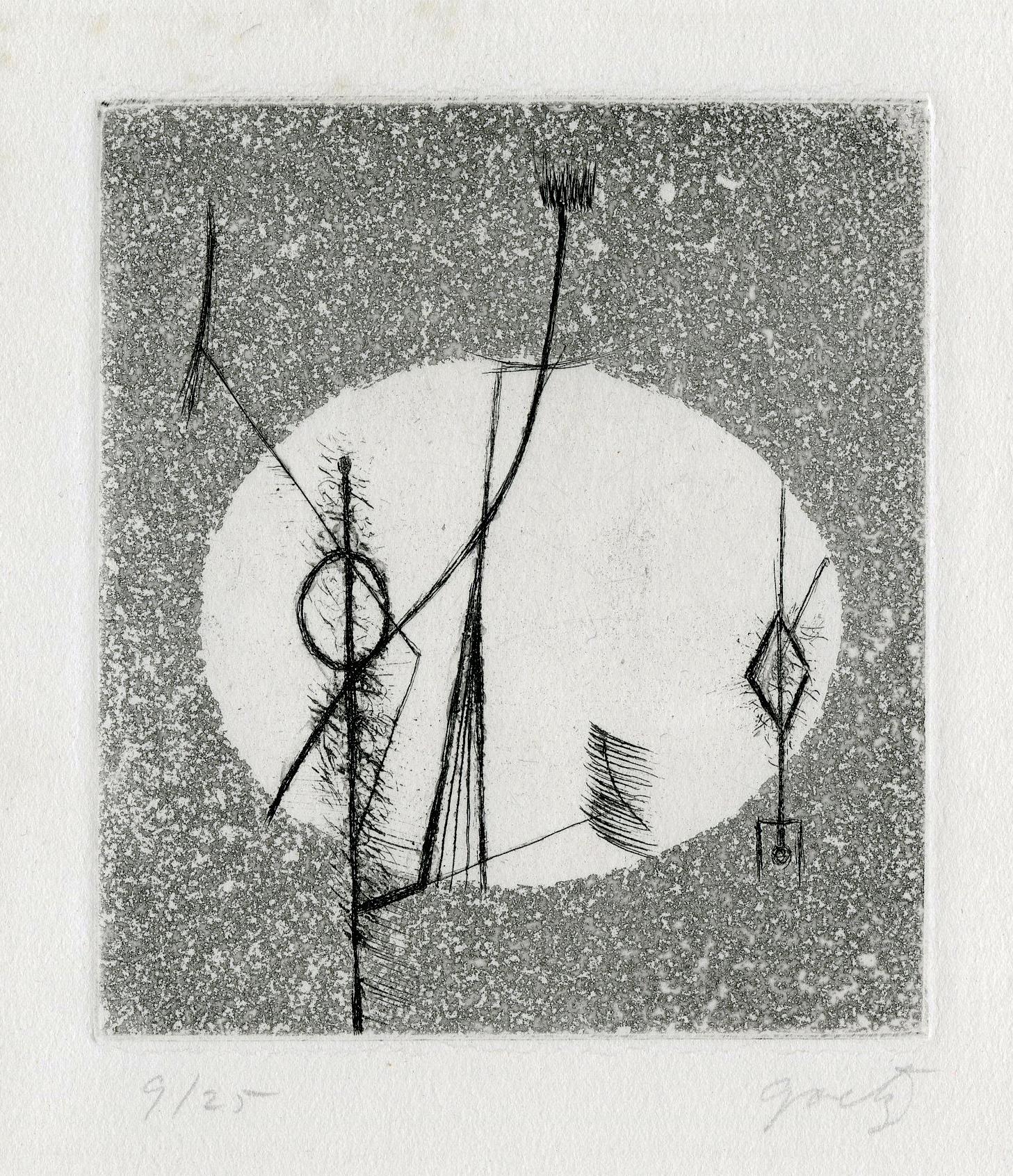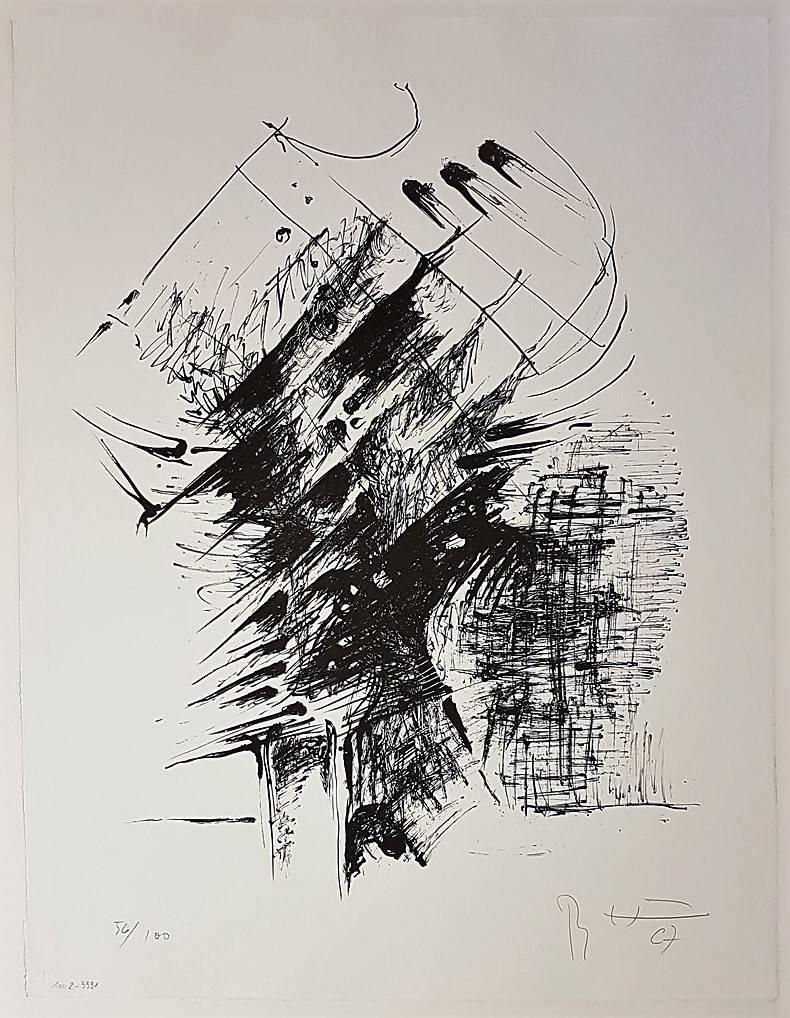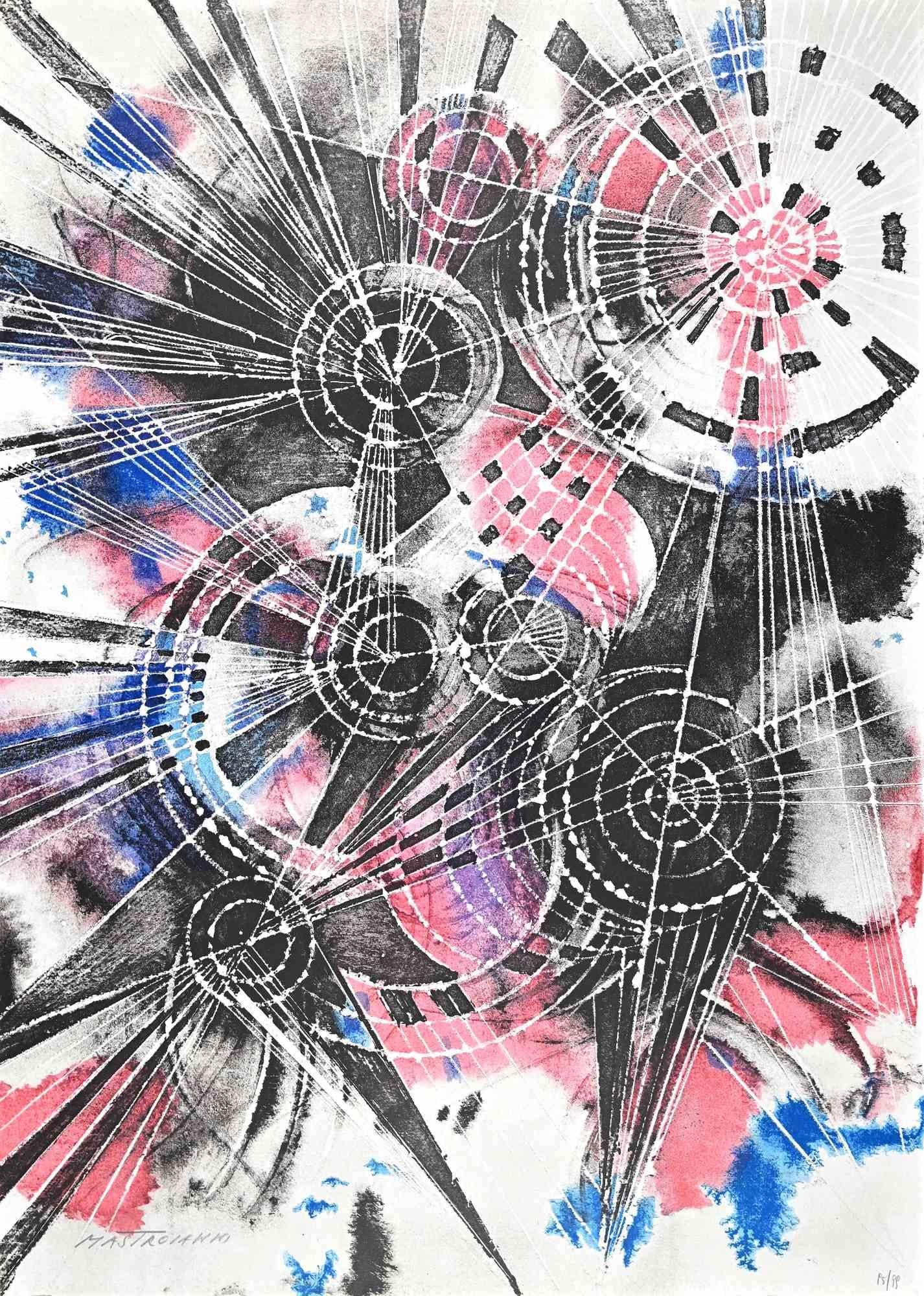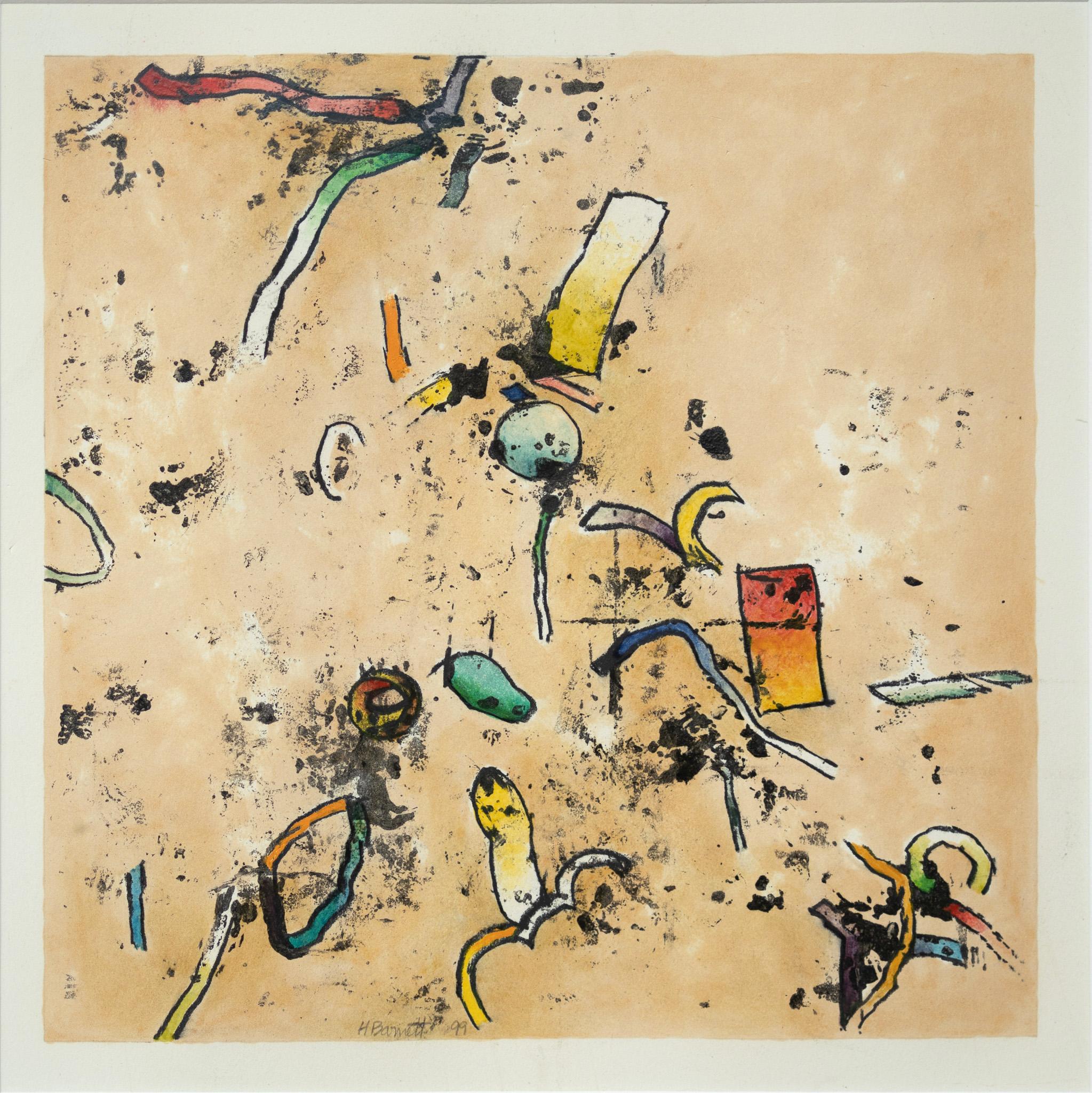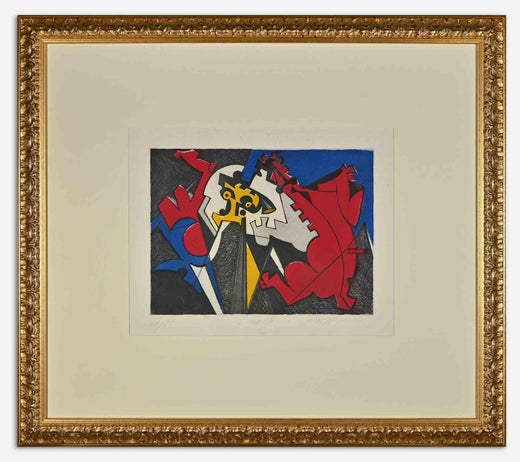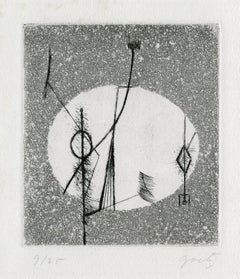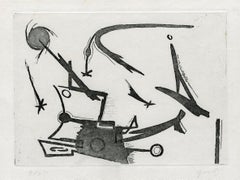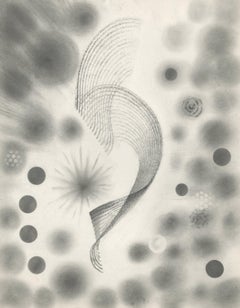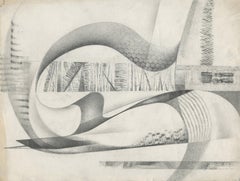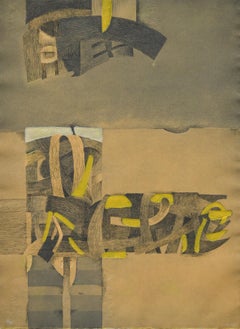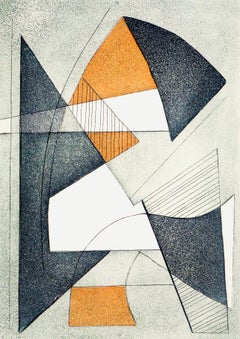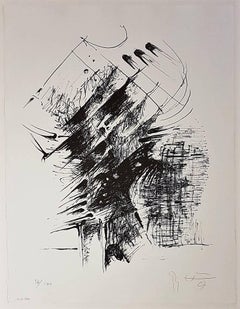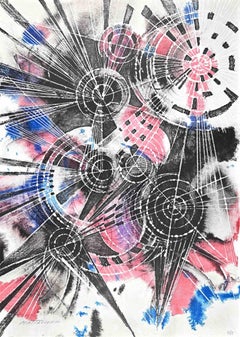Items Similar to Composition
Want more images or videos?
Request additional images or videos from the seller
1 of 10
Umberto MastroianniCompositionc. 1970
c. 1970
$600
£467.24
€531.48
CA$864.10
A$948.24
CHF 495.27
MX$11,337.29
NOK 6,273.49
SEK 5,851.21
DKK 3,969.44
About the Item
Composition
Original carborundum engraving, c. 1970
Signed: Mastroianni in pencil lower right (see photo)
Edition: 100 (76/100) (see photo)
Printed on a heavy laid paper
Condition: Excellent
Plate size: 15 1/2 x 11 9/16 inches
Sheet size: 20 x 13 3/8 inches
Lee Marshall for the Indepenent
Saturday 22 October 2011
UMBERTO MASTROIANNI was one of Italy's leading sculptors. After the Second World War, he cornered the market in municipal monuments to the Italian Resistance - which he had participated in - but his towering, dynamic creations in steel and bronze also found a place in museums and sculpture-parks from Los Angeles to Tokyo.
Mastroianni came from one of those families that breeds talent - all the more surprising as it was based in the rural backwater of Fontana Liri, in the mozzarella-belt of southern Lazio. His father Vincenzo was a master engraver, a craft that had been handed down from father to son for generations; his mother Luisa Conte was a cousin of the American actor Richard Conte. One of her grandsons, Marcello - Umberto's nephew - would go on to play with clay in his uncle's studio; later he remembered how Umberto had once made the family a Nativity scene out of snow).
Umberto travelled to Rome as a young teenager to study at the San Marcello art school and help out his uncle Domenico in his religious sculpture studio in Via Margutta, the Roman Montmartre. Two years later he was off to Turin, where he completed his apprenticeship with the sculptor Michele Guerrisi.
Mastroianni thrived on the city's lively art scene, forming friendships with second-wave Futurists like Luigi Spazzapan, who became a sort of mentor for the younger artist. It was another painter, Filippo De Pisis, who obtained Mastroianni his first one-man show, held in Genoa in 1931.
Through the Thirties, despite his Futurist sympathies, Mastroianni stayed resolutely figurative, sculpting lifesize bronzes in a pared-back classical manner close to that of Marino Marini. It was in 1942, as Italy's war effort began to disintegrate, that he finally embraced abstraction, developing a style that the critic Cesare Brandi would later define as "Cubist-Futurist".
The dynamic fringe of both movements fascinated Mastroianni: his models were Duchamp's Nude Descending a Staircase No 2 and Boccioni's unfinished sculptural experiments. His first important public commission, the Turin Monumento ai Caduti ("Monument to the Fallen Soldier") of 1945-47, was the first of a number of such commemorative sculptures - those in Cuneo, Urbino, Cassino and Frosinone are the most significant - in which the values of the Resistance were incarnated in a solid energy of broken circles and tilting planes.
Mastroianni's neo-Futurist shift was sealed with an influential Parisian show in 1951. Later exhibitions at the Venice Biennale (where he won the sculpture prize in 1958), New York (1964), Florence (1981) and Tokyo (1989) confirmed his international reputation. Though he produced many gallery- sized works in various media - clay, marble, copper and wood - he was never happier than when given the chance to work in bronze or steel on a grand scale, as in the towering Cuneo Resistance monument (1964), "a mountain", wrote the painter, "which served to clear my mind and put those critical labels in perspective". His last work was a pair of huge steel gates for Turin's Teatro Regio opera house, inaugurated in December 1994.
The sculptor's long Turin residence ended in 1960, when he moved to Marino, in the Castelli Romani east of Rome. He set up house in a 16th-century palazzo which had once belonged to the poetess Vittoria Colonna, Michelango's muse. Towards the end of his life he himself turned to poetry; he also wrote occasional columns on art for the Rome daily Il Messaggero. In March 1987, he donated a group of 27 works to the Italian state, including a series of polychrome reliefs (they can be seen at the Galleria di arte moderna in Rome).
Umberto Mastroianni was a big man with large, eloquent hands and an emphatic way of getting his point across. In moments of creative tension he would jump into his beloved Ferrari Dino and tear around the Castelli - even after he turned 80.
Umberto Mastroianni, sculptor: born Fontana Liri, Frosinone, Italy 21 September 1910; married Ida Perlo; died Rome 25 February 1998.
UMBERTO MASTROIANNI. SELECTION OF WORK (1931 - 1996)
Mirbach Palace (show Contact)
7. 5. 2008 - 15. 6. 2008
Curator: Floriano De Santi
BIOGRAPHY IN SHORT
Umberto Mastroianni was born in Fontana Liri, an ancient village in the province Frosinone, on 21 September 1910. In the year 1924 he came to Rome, where he used to visit the atelier of his uncle Domenico and drawing courses at the Academy San Marcello. In the year 1926 he moved with his family to Turin and he improved in the “sculpting craft” in the atelier of Michele Guerrisi. In the year 1930 he was for the first time given an official award by the Ministry of Education – “Premio del Turismo” and then gradually were coming subsequent exhibitions on both - national and European level - in the year 1935 Quadrennial in Rome and the following year Biennale in Venice. Filippo De Pisis appreciated his creation a lot, mainly because he was inspired by the ancient art of sculpting, Egyptian and Hellenic sculptures.
During WWII he was recruited into the army and then he actively took part in the defence. His own experience from concrete battles for freedom he later carried over into his creation and in this way he created “poetics of the defence” which was credited to him by Giulio Carlo Argan. In Turin he met the painter Luigi Spazzapano, an independent carrier of the alternative line in comparison to the “classicism” of Casorati as well as the cultural position of the group of painters “Gruppo dei Sei” bound to the heritage of the postimpressionists.
After the liberation he advertised supranational overcoming of the Italian culture according to the “historical avant-gardes”. In the year 1951 he had his first author’s exhibition in the most famous European gallery Galerie de France in Paris. However, he received his highest award at the XXIX Biennale in Venice in 1958, when he got the prize “Grand Premio Internazionale for the art of sculpting”.
In the years 1961 – 1969 he was the head of the Academy of Arts in Bologna, where he was also the head of the department of sculpting, from Turin he moved in the year 1970 to Marino Laziale, he taught first at the Academy of Arts in Naples and later in Rome. In the year 1973 the Academy Lincei awarded him with the prize “Premio Antonio Feltrinelli” for the “high ideal and shape quality of his work, remarkable influence onto the development of the modern sculpting art in Italy and mainly for his most important work Monumento alla Resistenza di Cuneo, which is a synthesis of a strong shaping engagement and a gigantic citizen’s feeling”.
In the year 1979 the Musée d’Art Moderne de la Ville in Paris again introduced the whole sculpting creation of Mastroianni in the cycle on post-war Italian sculpting. A year later, Floriano De Santi was the curator of an overview of his chromed sculptures, drawings, wooden reliefs and carvings. The works that time exhibited in Palazzo Ducale in Urbino, stress the creative expression, which for years is the object of interest of a few specialists. In the year 1979, almost like a proof of his infinite experimental talent he prepared for the Roman opera the scenography Coro dei morti according to the literary pattern from the poet Giacomo Leopardi and the music by Goffredo Petrassi.
In the year 1993 in Arpino (in the spaces of the Palazzo Ducale Boncompagni) and in Rome (in spaces of San Salvatore in Lauro) two Mastroianni’s museums opened under the leadership of Floriano De Santi. In the year 1994 the immense artwork Cancellata was placed into the Royal theatre in Turin and Mastroianni was awarded honourable citizenship.
In the night of the 25 February 1998 after a long and hard illness, Mastroianni died in his house – museum in Marino. Seven years after his death the Museo del Corso in Rome organised an important retrospective exhibition with the title “Umberto Mastroianni, sculptor of European importance” which introduced a collection of 170 works from the years 1927-28 – 1997.
- Creator:Umberto Mastroianni (1910 - 1998, Italian)
- Creation Year:c. 1970
- Dimensions:Height: 15.5 in (39.37 cm)Width: 11.57 in (29.39 cm)
- Medium:
- Movement & Style:
- Period:
- Condition:
- Gallery Location:Fairlawn, OH
- Reference Number:Seller: FA120011stDibs: LU14014117212
Umberto Mastroianni
Umberto Mastroianni (September 21, 1910 in Fontana Liri – February 25, 1998 in Marino, Italy), was an Italian abstract sculptor. In 1989, he received the first Praemium Imperiale for sculpture. During World War II, he was in the Italian resistance movement. He was the uncle of the actor Marcello Mastroianni and the film editor Ruggero Mastroianni. The Museo Civico Umberto Mastroianni was established in his honour. The son of Vincenzo Mastroianni and his second wife Luigia Maria Vincenza Conte, Umberto was an uncle of the actor Marcello Mastroianni: in fact, his father Vincenzo had had a son named Ottone from his first wife, Concetta Conte, sister of his second wife, who was Marcello's father. Umberto arrived in Rome as a 14-year-old in 1924, where he attended drawing courses at the Accademia di San Marcello at the same time as his uncle Domenico's studio. He moved two years later, in 1926.
The young Umberto modelled portraits of archaic taste, in terracotta, which were later transferred to bronze castings: myth and religious subjects were Umberto Mastroianni's stylistic hallmark in the pre-war period, alongside stylistic exercises with little boy heads and his favourite subject being masks of young women, with light and persuasive features. In 1930 came the first official recognition, the Tourism Prize, offered by the Ministry of Education and, shortly afterwards, the first exhibitions at national and European level. His first solo exhibition in 1931 at the ‘Galleria Genova’ in Genoa. From 1933 onwards, he regularly exhibited at national trade union exhibitions and was invited to all the Quadriennali in Rome, the Promotrici in Turin and the Biennali in Venice. In 1935 he took part in the Quadriennale in Rome for the first time, the following year in the Venice Biennale. His pictorial works on poor materials also date back to the early 1940s: he is the first Italian abstract sculptor, the leader of the 20th century revolution and an artist of absolute international importance. These are dynamic abstract-geometric forms that acquire depth in terracotta, plaster, cardboard and rough sacks (jute), coloured and scraped. Mastroianni's poetics decisively took up the echoes of the plastic dynamism of Boccioni's ascendancy, revisiting and broadening its contents and cultural references. Some of his early post-war works in worn-out jute (works of very small dimensions, almost as if they were relics of ancient civilisations, later found) are preserved in the Galleria d'arte moderna in Rome, the Tate Gallery in London, and the Salomon Guggenheim Museum in New York. In fact, his research, starting from direct references to the Futurist season, to Brancusi's Cubist season, to John Arp's and Henry Moore's plastics, hinges on the study and rendering of dynamic values, understood and conferred in the structures understood as a clot of lines of force, the generative nucleus of an explosion of gestures blocked by the weight of matter, trapped in matter. The subsequent evolution is the landing to the Informal season, (1950-1961) a completely autonomous phase, another act of his extraordinary creative personality.
About the Seller
5.0
Recognized Seller
These prestigious sellers are industry leaders and represent the highest echelon for item quality and design.
Gold Seller
Premium sellers maintaining a 4.3+ rating and 24-hour response times
Established in 1978
1stDibs seller since 2013
827 sales on 1stDibs
Typical response time: <1 hour
Associations
International Fine Print Dealers Association
- ShippingRetrieving quote...Shipping from: Fairlawn, OH
- Return Policy
More From This Seller
View AllUntitled
By Henri Goetz
Located in Fairlawn, OH
Untitled
Engraving, drypoint & carborundum, c. 1960's
Signed and numbered in pencil lower margin (see photos)
Edition: 25 (9/25)
Printed by the artist
Condition: Adhesive residue on ...
Category
1960s Abstract Expressionist Abstract Prints
Materials
Engraving
Untitled
By Henri Goetz
Located in Fairlawn, OH
Untitled
Signed in pencil lower right (see photo)
Edition: 25 (9/25) (see photo)
Engraving, drypoint & carborundum
Printed by the artist
Condition: Excellent, slight residue on rever...
Category
1960s Abstract Expressionist Abstract Prints
Materials
Drypoint, Etching
Untitled Abstraction
By Medard P. Klein
Located in Fairlawn, OH
Untitled Abstraction
Graphite on paper, c. 1950
Unsigned
Signed with the estate stamp verso (see photo)
Provenance: Estate of the artist
Inherited by his neighb...
Category
1950s Abstract Abstract Drawings and Watercolors
Materials
Graphite
Untitled Abstraction
By Medard P. Klein
Located in Fairlawn, OH
Untitled Abstraction
Graphite on paper. c. 1946
Unsigned
Provenance: Estate of the Artist
Inherited by his neighbor/caregiver
Condition: Staining at corners
...
Category
1940s Abstract Abstract Drawings and Watercolors
Materials
Graphite
Untitled
By Henri Goetz
Located in Fairlawn, OH
Untitled
Engraving, drypoint & carborundum, c. 1960's
Signed and numbered in pencil (see photos)
Edition: 25 (9/25)
Printed by the artist
Condition: Adhesive residue on the verso to...
Category
1960s Abstract Expressionist Abstract Prints
Materials
Engraving
Untitled
By Charles William Smith
Located in Fairlawn, OH
Untitled
Color woodcut, 1939
Unsigned as issued
Signed and dedicated by the artist on the justification page (see photo)
From:
Abstractions By Charles Smith
Forward by Carl O. Schnie...
Category
1930s American Modern Abstract Prints
Materials
Woodcut
You May Also Like
Untitled Edition 7 of 99
By Fernando de Szyszlo
Located in Miami, FL
Fernando de Szyszlo was a Peruvian painter best known for using pre-Columbian imagery and muted palette. De Szyszlo’s art was an attempt at reinventing Surrealist themes in a Latin A...
Category
20th Century Abstract Prints
Materials
Engraving, Etching
Projets de Pégase, Paroles peintes I, Alberto Magnelli
By Alberto Magnelli
Located in Southampton, NY
Etching on vélin Johannot d’Arches paper. Inscription: Unsigned and unnumbered, as issued. Good condition. Notes: From the album, Paroles peintes I, 1962. Published by Éditions O. La...
Category
1960s Modern Landscape Prints
Materials
Etching
$3,036 Sale Price
20% Off
Free Shipping
"Komposition" (Composition)
By Bernhard Heiliger
Located in Kansas City, MO
Bernhard Heiliger
“Composition III”, 1967
Medium: Lithograph
Signed, numbered or inscribed
Edition: 100 + H.C.
Size: 20.5 × 12.9 on 25.5 × 19.7 inches
COA provided
Bernhard Heiliger...
Category
1960s Abstract Abstract Prints
Materials
Lithograph
Composition - Lithograph by U. Mastroianni - 1980s
By Umberto Mastroianni
Located in Roma, IT
Composition is a contemporary artwork realized by Umberto Mastroianni.
Mixed colored litograph. Hand-signed by the artist on the lower left in pencil. Numbered on the lower right in...
Category
1980s Abstract Abstract Prints
Materials
Lithograph
Untitled
Located in Austin, TX
Artist: Helmut Barnett
Medium: Mixed Media Lithograph
Sheet Size: 12" x 10"
Framing: Framed
Condition: Excellent
Category
21st Century and Contemporary Abstract Abstract Prints
Materials
Mixed Media, Lithograph
$1,200
Composition #111
By Renaud Allirand
Located in Palm Springs, CA
Signed and numbered from the edition of 12.
RENAUD ALLIRAND was born in 1970, and currently lives and works in Paris. He is a prolific artist who has exhibited regularly since 1995....
Category
Early 2000s Abstract Abstract Prints
Materials
Drypoint, Etching
More Ways To Browse
Ancient Egyptian Art
Nativity Scene
Used Steel Gates
Irwin Hollander
Jean Michel Basquiat Signed
Jim Dine Signed 8 Hearts
Joan Miro Carborundum
John Chamberlain On Sale
Marcel Mouly Signed Print
Michael Abramson
Misch Kohn
Peter Max Images Of An Era
Pierre Soulages Poster
Raza Sayed
Richard Smith Orange
Salvador Dali Currier And Ives
Salvador Dali Illustration
Sam Francis Original
